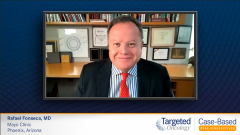
A Case of Transplant-Ineligible MM: Frontline Daratumumab-based Triplet Therapy
Rafael Fonseca, MD, provides details on a patient case of transplant-ineligible multiple myeloma and reviews the selection of frontline triplet versus doublet therapy.
Episodes in this series

Transcript:
Rafael Fonseca, MD: Hello, and welcome to this Targeted Oncology™ program about the evolving treatment landscape of newly diagnosed multiple myeloma. I’m Rafael Fonseca, a professor of medicine in the division of hematology and oncology at the Mayo Clinic in [Phoenix] Arizona. I’m also the chief innovation officer. I’m going to be discussing a number of updates for the treatment of multiple myeloma that were presented at ASH [American Society for Hematology Annual Meeting]. I’ll also present a clinical case and discuss my treatment approach to this particular scenario and how we incorporate recent evidence into our clinical practice.
Here is our case. This is an 81-year-old man who was diagnosed with myeloma lambda [light chain] type. He was International Staging System stage III and Revised International Staging System stage II. He had quite an elevated free lambda light chain at the time of diagnosis, 9587 mg/L, which would be 958 mg/dL. The patient had a positive PET [positron emission tomography] scan ... as well as a collapse at the level of T7 with no obvious extramedullary disease. The patient had a history of diabetes and hypertension, as well as an ECOG performance status of 2. Based on the patient’s age and comorbidities, he was deemed to be ineligible for a stem cell transplant, so he was started on the combination of daratumumab, lenalidomide, and dexamethasone. With this, the patient was able to achieve a complete response.
This is a patient that many of us would see in the clinic. As a person of an advanced age, 81, he does have comorbidities. But even in the absence of comorbidities, one has to be quite mindful of the drugs and the dosage of the drugs to be used in a situation like this. In our clinical practice, I’ve taken daratumumab-lenalidomide-dexamethasone as the standard of care for this patient population. But even then, we have to do some dose adjustments…. Oftentimes, we’ll start with a slight reduction, at least in the dexamethasone doses. For many of these patients I’d start with 1 dose of 20 mg. I’d offer the patient a treatment with a triplet. There are some circumstances where we might go with a doublet, but they’re far and far between, particularly because of the combination of the 3 agents I mentioned.
Those are well-tolerated treatments for patients, so that’s what I would do in my clinical practice. I’d follow the patient quite closely and work with the nursing staff so that we have close monitoring of the situation. Ideally, we want the patient to stay on therapy for as long as possible. The durability of the responses—we’ll talk more about this during this program—can be quite long. I’d make the same choice, and I’d provide significant support to an individual in such a situation.
For transplant-ineligible myeloma, we have 2 main recommendations supported by most of the therapeutic guidelines, certainly the main ones in the United States, the NCCN [National Comprehensive Cancer Network] and mSMART [Mayo Stratification of Myeloma and Risk-Adapted Therapy]. They’re both supported by category 1 evidence: the triplet of our RVd [lenalidomide, bortezomib, dexamethasone] or the triplet of daratumumab, lenalidomide, and dexamethasone. There are other options at the global level, but those should be the main ones used for this patient population. There’s an exception. If a patient has quite a frail status, and we think even 3 drugs like this might be harsh, then it could be treated with a doublet. But that’s more the exception than the rule. Those are the 2 main regimens we’re using for patients who are transplant ineligible.
Our selection of a triplet vs a doublet therapy is guided by a number of factors. It can’t be age alone because we have people who are in their late 70s or 80s but are quite fit and would be able to tolerate the triplet. It’s more the frail status and the presence of comorbidities that dictate who might not be the best candidate for a triplet. But with the use of daratumumab, which is quite well tolerated, our focus on the toxicities has been more on lenalidomide and particularly dexamethasone. But it’s mostly the presence of that frail status and comorbidities.
When one thinks about multiple myeloma, one has to think about 3 categories. We have a third of patients who go through the stem cell transplant pathway, a third who are not candidates for stem cell transplant but who are quite fit, and a third who may have some aspects of comorbidities, frail status, and so forth. Many of them can receive a triplet, but that’s where you need to focus and pay more attention with regard to the treatment selection.
Transcript edited for clarity.









































